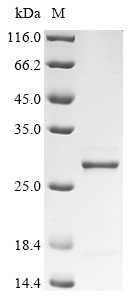Recombinant Conus marmoreus Mu-conotoxin MrVIB
CAT:
399-CSB-EP637699DWD-03
Size:
1 mg
Price:
Ask
- Availability: 24/48H Stock Items & 2 to 6 Weeks non Stock Items.
- Dry Ice Shipment: No




Recombinant Conus marmoreus Mu-conotoxin MrVIB
- CAS Number: 9000-83-3
- UniProt: Q26443
- Expression Region: 52-82aa
- Organism: Conus marmoreus (Marble cone)
- Target Sequence: ACSKKWEYCIVPILGFVYCCPGLICGPFVCV
- Tag: N-terminal GST-tagged
- Source: E.coli
- Field of Research: Others
- Assay Type: Developed Protein
- Relevance: MuO-conotoxins are gating-modifier toxins that inhibit sodium current by trapping the domain II voltage sensor in the closed position to prevent opening of the sodium channel. This toxin has a preference for Nav1.4/SCN4A over Nav1.2/SCN2A sodium channels. It blocks Nav channels by interacting mainly with the C-terminal part of the pore loop of domain-3. It also blocks fast-inactivating calcium current. Blocks Nav1.8/SCN10A sodium channels and has potent and long-lasting local anesthetic effects. It can also block propagation of action potentials in A- and C-fibers in sciatic nerve as well as skeletal muscle in isolated preparations.
- Purity: Greater than 85% as determined by SDS-PAGE.
- Activity: Not Test
- Length: Full Length of Mature Protein
- Form: Liquid or Lyophilized powder
- Buffer: If the delivery form is liquid, the default storage buffer is Tris/PBS-based buffer, 5%-50% glycerol. If the delivery form is lyophilized powder, the buffer before lyophilization is Tris/PBS-based buffer, 6% Trehalose, pH 8.0.
- Reconstitution: We recommend that this vial be briefly centrifuged prior to opening to bring the contents to the bottom. Please reconstitute protein in deionized sterile water to a concentration of 0.1-1.0 mg/mL.We recommend to add 5-50% of glycerol (final concentration) and aliquot for long-term storage at -20℃/-80℃. Our default final concentration of glycerol is 50%. Customers could use it as reference.
- Molecular Weight: 30.3 kDa
- References & Citations: "Synthetic muO-conotoxin MrVIB blocks TTX-resistant sodium channel NaV1.8 and has a long-lasting analgesic activity." Bulaj G., Zhang M.M., Green B.R., Fiedler B., Layer R.T., Wei S., Nielsen J.S., Low S.J., Klein B.D., Wagstaff J.D., Chicoine L., Harty T.P., Terlau H., Yoshikami D., Olivera B.M. Biochemistry 45:7404-7414 (2006)
- Storage Conditions: The shelf life is related to many factors, storage state, buffer ingredients, storage temperature and the stability of the protein itself. Generally, the shelf life of liquid form is 6 months at -20℃/-80℃. The shelf life of lyophilized form is 12 months at -20℃/-80℃.
